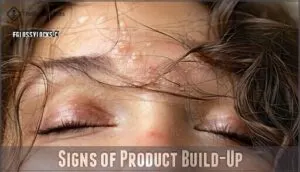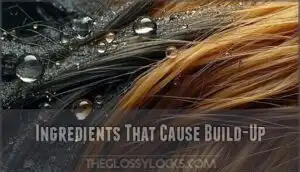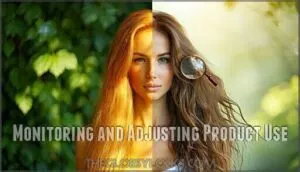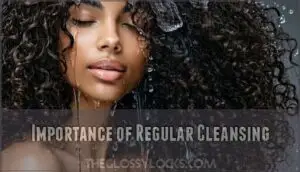This site is supported by our readers. We may earn a commission, at no cost to you, if you purchase through links.
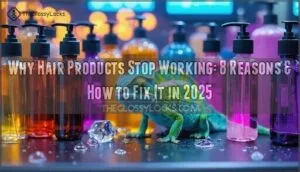
Your hair’s texture and porosity shift over time due to hormonal changes, aging, and environmental factors like hard water or humidity fluctuations. Heat damage increases oil production by 47%, while hormonal shifts can alter product responsiveness by up to 35%. Weather changes affect performance too – humidity cranks up frizz by 64%.
Your once-perfect routine becomes mismatched when your hair evolves but your products stay the same, creating that frustrating "it used to work" scenario. The solution involves understanding these hidden factors disrupting your hair’s chemistry.
Table Of Contents
- Key Takeaways
- Why Do Hair Products Stop Working?
- How Product Build-Up Impacts Hair Effectiveness
- Adapting Your Hair Care Routine for Better Results
- Best Practices and Recommended Products for Ongoing Hair Health
- Frequently Asked Questions (FAQs)
- How often should I use hair products?
- What are the best ingredients to look for in a hair product?
- Is there an age limit for using hair products?
- Are there any potential side effects to using hair products?
- Are there any natural alternatives to using hair products?
- Can hair type changes affect product performance?
- Should you switch products during pregnancy?
- Can medication side effects reduce product results?
- Do hair extensions interfere with product absorption?
- Conclusion
Key Takeaways
- Your hair is constantly changing due to hormones, aging, and environment, so products that worked before won’t necessarily work now – you’ll need to adjust your routine as your hair evolves.
- Product buildup creates an invisible barrier that blocks new products from penetrating your hair shaft effectively, making even your favorite formulas feel ineffective until you clarify properly.
- Environmental factors like humidity (increases frizz by 64%), hard water (reduces effectiveness by 37%), and heat damage (boosts oil production by 47%) dramatically impact how well your products perform.
- You can fix most product failures by rotating your routine seasonally, using clarifying shampoos weekly to remove buildup, and monitoring your hair’s changing needs rather than sticking to the same products indefinitely.
Why Do Hair Products Stop Working?
You’ve probably noticed your go-to shampoo or styling cream doesn’t work like it used to, leaving your hair flat, greasy, or unmanageable.
Here’s what’s really happening: your hair keeps changing on you. Product buildup coats each strand over time. Your hormones shift and throw everything off balance. Daily exposure to sun, pollution, and heat styling takes its toll.
And as we age, our hair literally changes structure – becoming more porous or losing its natural oils.
Changes in Hair Needs Over Time
Your hair’s like a living canvas that’s constantly changing. As you age, hormones shift, and lifestyle evolves, your hair’s texture and porosity naturally transform, making once-perfect products suddenly ineffective.
- Hair Evolution: Follicle structure changes with age, altering how products absorb
- Texture Shifts: Fine hair may coarsen or curly hair may relax over time
- Porosity Changes: Damaged cuticles affect product penetration and retention
- Product Rotation: What worked at 20 won’t necessarily work at 40
- Seasonal Adjustments: Your hair care routine needs tweaking as environmental changes occur
Product Build-Up and Scalp Health
Product buildup creates a barrier that blocks your scalp’s natural processes and prevents new products from penetrating effectively. When oils, silicones, and styling residues accumulate, your scalp microbiome becomes imbalanced, leading to dullness and reduced product performance.
Here’s how buildup affects your hair:
| Buildup Symptoms | Scalp Health Impact | Product Rotation Need |
|---|---|---|
| Greasy, heavy feel | Clogged follicles | Weekly deep cleanse |
| Dull appearance | Disrupted pH balance | Alternate light/heavy products |
| Poor style hold | Reduced circulation | Monthly clarifying treatment |
Regular scalp cleansing with clarifying shampoos removes this barrier, restoring ingredient awareness and effectiveness.
Environmental and Lifestyle Factors
Weather changes dramatically affect your hair’s performance with products. Thermal damage from heat increases scalp oil by 47%, while humidity creates frizz in 64% of hair types. UV exposure and pollution degrade your hair cuticles by 29%. Hard water deposits minerals, causing 37% of product failures.
Lifestyle changes like moving locations or switching habits disrupt your routine’s effectiveness.
Hormonal and Biological Changes
Your body’s internal changes can sabotage your favorite products’ performance. Hormonal fluctuations during pregnancy, menopause, or monthly cycles alter hair texture and product responsiveness by up to 35%.
Several biological factors mess with your routine. After 40, age-related shifts reduce thickening product effectiveness by 28%. Nearly half of new mothers deal with postpartum effects that impact their hair health. Hair shedding creates unmet needs for about three-quarters of women’s routines.
These lifestyle changes require adjusting your hair care approach accordingly.
These lifestyle changes require adjusting your hair care approach accordingly.
How Product Build-Up Impacts Hair Effectiveness
When you layer styling products, conditioners, and treatments without proper cleansing, residue accumulates on your hair shaft and creates an invisible barrier that blocks new products from penetrating effectively.
This buildup doesn’t just make your hair feel heavy and dull—it actually prevents your favorite products from doing their job, leaving you wondering why nothing seems to work anymore.
Signs of Product Build-Up
Recognizing product buildup starts with closely observing your hair’s behavior. Scalp itchiness develops when residue traps dirt and irritates the skin, while limp strands lose volume despite using root-boosting products. Your hair shows product resistance when styling becomes difficult. One key indicator is noticing residues from styling products that accumulate over time.
| Physical Signs | Scalp Symptoms | Performance Issues |
|---|---|---|
| Dull appearance lacking natural shine | Scalp irritation and redness | Curls loosen unexpectedly |
| White residue on brushes | Blocked hair follicles | Products stop working effectively |
| Frizzy, lifeless texture | Increased dandruff formation | Volume disappears within hours |
| Tangled hair that’s hard to detangle | Trapped sweat and oil | Styles won’t hold properly |
| Oily feel despite washing | Uncomfortable scalp sensations | New hair products fail immediately |
Regular hair clarification prevents these issues from developing into serious scalp and hair maintenance problems.
Ingredients That Cause Build-Up
Several common ingredients create stubborn buildup on your hair strands. Silicone Accumulation forms protective films that trap moisture underneath, while Wax Residue from styling products creates heavy coatings that shampoo can’t remove easily. A common issue is product accumulation on hair.
- Oil Overload from heavy moisturizers saturates hair cuticles
- Butter Buildup from thick creams weighs down fine hair
- Polymer Deposits from gels and mousses layer repeatedly
- Cosmetic chemistry creates formulas that bond too strongly
Cleansing Methods to Remove Build-Up
Once buildup accumulates, you’ll need targeted cleansing approaches. Clarifying Shampoos work best weekly to remove Product Buildup without daily stripping. DIY Cleansers like apple cider vinegar effectively strip residue.
Scalp Exfoliation helps remove stubborn deposits. Consider Clarifying Charcoal Shampoo Bar alternatives or gentle cowash methods.
When product buildup starts weighing down your hair, it’s time to get strategic about removal. Clarifying shampoos are your best bet – use them weekly to strip away residue without over-drying your hair daily. DIY options like apple cider vinegar work surprisingly well at cutting through stubborn buildup.
Scalp exfoliation tackles the deposits that regular washing misses. Try a clarifying charcoal shampoo bar or gentle cowash methods for variety.
Tune your washing frequency based on how well your products are working. Stay aware of ingredients to keep winning the buildup battle long-term.
Your hair’s environment directly impacts how well your products work, with factors like humidity increasing frizz by 64% and hard water reducing product effectiveness by 37%.
Temperature changes, UV exposure, and even your body’s hormonal shifts create a moving target that requires you to adjust your routine throughout the year.
Here’s the thing about your hair – it’s constantly reacting to whatever’s going on around it. Humidity can bump up frizz by 64%, and if you’ve got hard water, your products are working 37% less effectively than they should.
Temperature swings, sun damage, and even your hormones are constantly shifting the game. It means you can’t just set it and forget it – your routine needs to adapt as conditions change throughout the year.
Weather plays a bigger role in your hair products’ performance than you might think. High humidity increases frizz and unruliness in 64% of hair types, making your styling products work overtime.
Thermal damage from rising temperatures boosts scalp oil production by 47%, creating environmental buildup that reduces product effectiveness.
UV hair damage breaks down your hair’s protective cuticle, especially in polluted areas where damage jumps 29%. This combination forces many people into product rotation strategies to maintain results as conditions change throughout the year.
Hard Water and Mineral Deposition
Hard Water Minerals create a stubborn coating on your hair shaft, blocking product absorption and leaving strands dull. These calcium and magnesium deposits reduce hair product performance by up to 40%, making even premium products feel ineffective.
- Chelating Shampoos break down mineral buildup weekly, restoring product effectiveness
- Water Softeners eliminate 90% of minerals, preventing future hair damage and repair issues
- DIY Rinses using apple cider vinegar help prevent product buildup between deep cleans
Regular hair care and maintenance with clarifying treatments keeps hair health issues at bay.
Adapting Your Hair Care Routine for Better Results
Your hair’s changing needs require you to monitor and adjust your routine regularly, just like updating your phone’s software for better performance.
You’ll need to switch up your cleansing frequency and product selection based on seasonal changes, hormonal shifts, and your hair’s current condition to maintain peak results.
Monitoring and Adjusting Product Use
Track your hair’s changing moods like a detective solving a mystery. Your locks don’t stay the same year-round, so neither should your routine adaptability.
Notice when your usual products fall flat during seasonal adjustments—maybe your winter moisturizer feels too heavy in summer humidity. Keep a mental hair diary for effective scalp monitoring and ingredient awareness.
Product rotation isn’t just trendy; it’s smart hair regimen customization. When your hair whispers for change, listen and pivot your hair care and maintenance approach accordingly.
Importance of Regular Cleansing
Your scalp microbiome thrives on balance, not squeaky-clean flawlessness. Regular cleansing frequency matters more than you think – washing every 3-5 days prevents product buildup while maintaining healthy hair’s natural oils.
Think of shampoos as reset buttons for your hair care routine. When product absorption decreases, your curls send distress signals through dullness and limpness.
Effective buildup prevention starts with consistent curl maintenance habits that respect your hair’s natural rhythm.
Best Practices and Recommended Products for Ongoing Hair Health
You’ll want to maintain your hair’s health by selecting products that match your hair’s current needs and establishing a consistent cleansing routine.
The right combination of sulfate-free shampoos, moisture-rich conditioners, and weekly deep treatments prevents buildup while keeping your hair responsive to styling products.
Keeping your hair healthy comes down to two basics: picking the right products for what your hair actually needs right now, and sticking to a routine that works.
The magic happens when you combine sulfate-free shampoos, conditioners that actually add moisture, and those weekly deep treatments that prevent buildup without making your hair fight against your styling products.
When your current shampoo isn’t delivering, Cantu’s sulfate-free formula gently removes heavy buildup while preventing breakage. This affordable solution resolves common hair routine frustrations.
Key benefits for product buildup prevention:
When your current shampoo isn’t delivering, Cantu’s sulfate-free formula gently removes heavy buildup while preventing breakage. This affordable solution resolves common hair routine frustrations.
What makes this formula work for tackling buildup:
- No sulfates, parabens, or silicones to prevent scalp sensitivity
- 100% pure shea butter enhances moisture retention
- Rich lather removes heavy buildup without stripping natural oils
- Promotes curl definition in coils, waves, and locs
- Safe for natural and color-treated beauty products
Among the Gentle Cleansing options for buildup prevention, Aunt Jackie’s Coco Wash stands out with its coconut milk foundation. Coconut milk hydrates hair and treats dry scalp, while avocado and shea butter create excellent therapy for all hair types, gentle enough for daily use.
This co-wash delivers Scalp Hydration without stripping natural oils, maintaining Curl Definition while preventing future buildup accumulation.
Coconut-Sugar Cane Conditioner
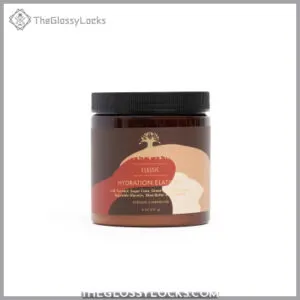
Coconut-sugar cane conditioners deliver powerful ingredient synergy through natural humectants that lock moisture into damaged cuticles. These sustainable sourcing formulations reduce scalp sensitivity while providing enhanced conditioner benefits compared to synthetic alternatives.
Hair products featuring this combination show enhanced beauty product effectiveness through improved cosmetic chemistry and formulation. You’ll find these conditioners work exceptionally well for maintaining product performance over time.
Coconut and sugar cane conditioners work well together because their natural compounds pull moisture into hair that’s been damaged. These ingredients come from sustainable sources and tend to be gentler on your scalp than synthetic options.
Hair products with this combo show strong results through better formulation chemistry. They maintain their effectiveness longer than many alternatives.
Treating your hair with a deep conditioning flaxseed cap transforms dry, brittle strands into moisturized loveliness. This DIY hair treatment combines flaxseed benefits with heat activation for improved product formulation absorption. The cap alternatives create an ideal environment for hair moisturizing through application techniques that boost penetration.
- Heat activation heightens the deep conditioning treatment’s effectiveness by opening hair cuticles
- DIY recipes using flaxseed gel provide natural protein and omega-3 fatty acids for repair
- Application techniques with thermal caps guarantee even distribution and better hair product absorption
Curl & Shine Shea Moisture Conditioner
Shea Moisture’s curl-defining conditioner addresses frizzy hair with coconut oil and shea butter. These ingredients provide moisture retention while enhancing shine and curl definition.
You’ll find it works well for medium to coarse curls needing extra hydration. When selecting conditioners, consider your curl pattern and porosity.
This product alternatives other heavy creams if your hair craves rich moisture without weighing down your natural texture.
Organic Aloe Vera Conditioner
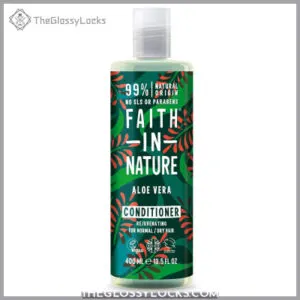
Why settle for synthetic conditioners when organic aloe vera conditioner delivers exceptional scalp hydration? These conditioners utilize aloe benefits through organic sourcing, providing natural moisture without harsh chemicals.
You’ll find various conditioner types featuring aloe, from lightweight formulas to rich treatments. DIY recipes using pure aloe gel offer cost-effective alternatives.
This organic approach aids your hair routine maintenance while addressing specific curl product selection needs for healthier hair products overall.
Garnier Ultimate Argan-Almond Hair Mask
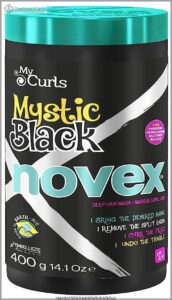
Garnier’s Best Argan-Almond Hair Mask delivers powerhouse Argan-Almond benefits through intensive conditioning. Apply this hair treatment to damp strands, focusing on mid-lengths and ends.
The ingredient analysis reveals nourishing oils that penetrate damaged cuticles.
Suitable for most hair types experiencing dryness, this mask outperforms basic conditioners in product comparison studies, making it essential for effective hair maintenance.
Eden Jojoba Monoi Hair Conditioner
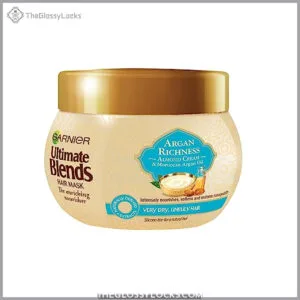
Eden Jojoba Monoi Hair Conditioner combines lightweight jojoba oil with monoi for deep moisture without weighing hair down. This conditioner works well for fine to medium hair types seeking hydration.
Apply mid-length to ends, focusing on damaged areas. The jojoba monoi benefits include improved elasticity and shine.
Proper application techniques help achieve product longevity and effectiveness.
Frequently Asked Questions (FAQs)
How often should I use hair products?
Like clockwork, hair products need timing. You’ll find your groove washing two to three times weekly .
Every two to three days works for most people, but listen to your strands—they’ll tell you when they’re thirsty.
What are the best ingredients to look for in a hair product?
You’ll want keratin for strength, biotin and rosemary extract for growth assistance, hyaluronic acid for moisture, and salicylic acid to remove buildup. These science-backed ingredients actually deliver results.
Is there an age limit for using hair products?
Think grandma’s cabinet of potions—there’s no retirement age for hair products! Gentle cleansing and styling products work safely across ages, but chemical processing like bleaching should wait until after puberty.
Are there any potential side effects to using hair products?
Yes, you can experience side effects from hair products. Common reactions include scalp itching, redness, burning, and scaling.
Fragrances, preservatives, and bleaching agents often trigger allergic contact dermatitis . Even products you’ve used safely can suddenly cause reactions.
Are there any natural alternatives to using hair products?
Natural oils, vinegars, and butters replace commercial products effectively. Coconut oil moisturizes deeply, while apple cider vinegar clarifies buildup and balances pH. Aloe vera soothes scalp irritation naturally.
Can hair type changes affect product performance?
Hair type changes absolutely affect product performance. Your hair’s porosity, thickness, and texture shift due to age, hormones, damage, or treatments, requiring different formulations for best results.
When your hair changes, your products need to change too. As hair gets more porous, thicker, or changes texture—whether from aging, hormones, damage, or chemical treatments—the same old shampoo and conditioner just won’t cut it anymore.
Coincidentally, the same spring pollen that makes you sneeze also wreaks havoc on your scalp.
Seasonal allergies trigger inflammation and irritation, creating an inflamed environment where your favorite styling cream suddenly can’t penetrate or perform effectively.
Should you switch products during pregnancy?
Pregnancy hormones can dramatically shift your hair’s needs, making familiar products less effective. Consider switching if you notice increased oiliness, dryness, or texture changes during your pregnancy journey.
Can medication side effects reduce product results?
Ironically, medications meant to improve your health can sabotage your scalp’s circulation. Beta-blockers lower blood pressure and heart rate, reducing blood flow to peripheral areas of the body, including the scalp.
When blood flow drops, your hair products can’t absorb properly or deliver nutrients effectively.
Do hair extensions interfere with product absorption?
Extensions create a barrier between your scalp and products, reducing their effectiveness. Sweat, dirt, and styling products get trapped against your scalp, preventing proper absorption while compromising hair health.
Conclusion
Understanding why hair products stop working is like solving a puzzle—each piece reveals how your hair’s evolving needs create product mismatches. Your hair’s porosity, texture, and chemical response patterns shift constantly due to hormonal fluctuations, environmental exposure, and product buildup.
You’ll maintain healthier hair by regularly clarifying, rotating products, and adjusting your routine seasonally. Monitor your hair’s signals and adapt accordingly—flexibility beats brand loyalty every time.
Hair products that suddenly stop working aren’t failing you—your hair is changing. Porosity shifts, texture evolves, and your scalp’s chemistry adapts to hormones, weather, and whatever you’ve been putting on it.
Your hair products stop working because your hair is constantly evolving while your routine stays the same
What worked last month might be completely wrong for your hair today.
- https://justnutritive.com/why-do-products-to-thicken-hair-stop-working/
- https://loveurcurls.com/blogs/news/product-buildup-in-hair
- https://www.nexxus.com/us/en/haircare-101/how-to-tell-if-your-hair-has-product-build-up.html
- https://www.redken.com/blog/why-the-ph-of-your-hair-is-important.html
- https://www.crodabeauty.com/en-gb/resources/blog/preventative-hair-care-protecting-from-environmental-aggressors

